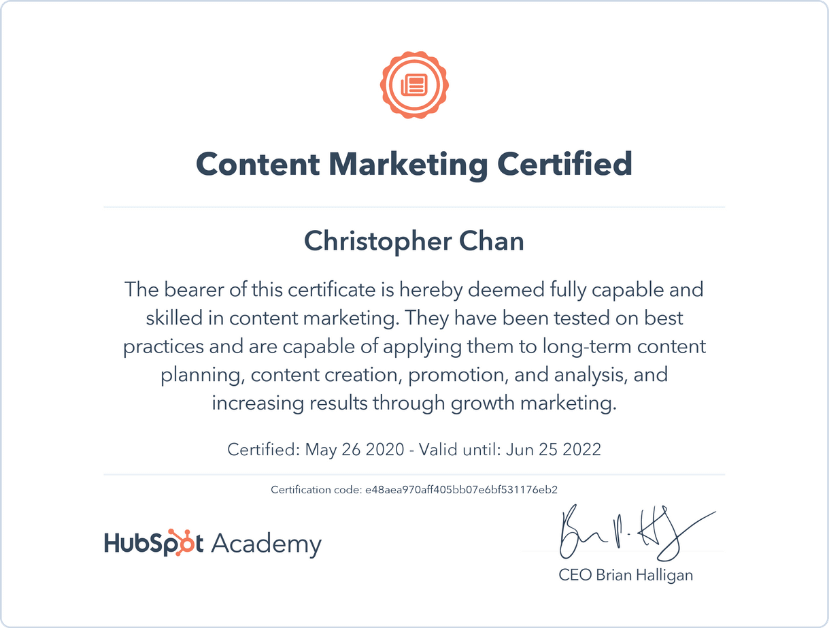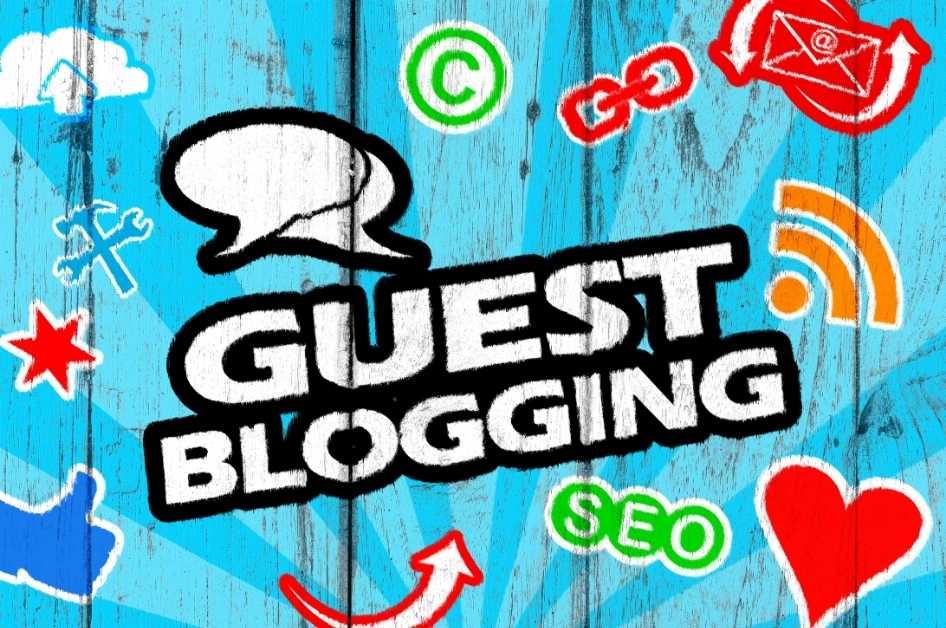DIGITAL MARKETING
Is Hubspot’s Content Marketing Certification Worth It? 11 Key Skills
Chris Chan, Digital Marketing Consultant
19 January 2021
In 2020 Hubspot generated over $800,000 in Revenue.
You’d expect a big company like that to build filled with malicious intent and scammy marketing to rip people off.
Hubspot is the exact opposite.
Hubspot’s Content Marketing Certification Course is worth it. Take the course and certification here.
Don’t want to go through the trouble of taking the course yourself?
Here are the 11 Game-Changing Content Marketing skills I learned from Hubspot Academy’s Content Marketing Certification Course.
Disclaimer: This post contains Amazon affiliate links, making any purchases through the links in this post will support Chris Dismissed at no additional cost to you.

1. You Need to Tell a Story
The Secret sauce behind great content is excellent storytelling.
Think about it.
Every time you sit down to write a fantastic piece of content, you’re solving a problem through engaging storytelling.
According to Hubspot, people want to feel like they belong, relate, and are stimulated by great content. And a story is an incredible way to do that!
Great stories also help you align with your target audience and literally get on the same page as them.
Your story needs to have characters, conflict, and ultimately a resolution (which ideally will be your product/service).
The first and most crucial element of the story is conflict.
What is the problem that you are trying to solve with your content?
According to Hubspot, your content should serve at least one of these purposes…
- Educate
- Inform
- Entertain
- Persuade
Knowing which category your content falls into will allow you to choose what problem or conflict you are attempting to resolve.
Even the most mundane topics, like plumbing and engineering, can come alive with great storytelling.
People want to be part of a larger narrative. Your marketing can help them get there.
What’s the story that you’re telling with your business?
One great example that Hubspot uses to show this is the shoe company TOMS.
TOMS is committed to giving one pair of shoes to the needy every time you buy shoes.
This drastically increases its sales and target audience. People who want to make a positive change for the needy can now buy a shoe that gives them that benefit.
Every great piece of content solves a problem and tells an engaging story.

2. Having a Content Creation Framework is Crucial For Long-Term Success
If you’re an aspiring content creator like I know how easy it is to get sloppy and unorganized during your creation process.
To no surprise, the people at HubSpot feel our pain on a personal level.
This is where a solid content creation framework comes in!
According to Hubspot, a content creation framework is a process that takes you through the entire process of creating multiple pieces of content.
You can think of a content creation framework as the tracks for your content train.
For me, this would be the processes and Standard Operating Procedures (SOP) that I go through every single time I create anything.
So what are the elements of a great content creation framework?
Firstly, every content creation framework should start with short-term and long-term goals.
What goals are you trying to achieve with your content, and when do you want to achieve those goals?
Is your goal to increase ROI? Perhaps you’re trying to snatch up some brand awareness, or perhaps you’re like me, just trying to get some traffic onto your site.
Once you have your short-term and long-term goals, it’s time to construct processes to achieve those goals.
The beautiful people at Hubspot believe that every piece of content should go through 5 distinct process points.
- Conceptualizing Content
- Planning a Timeline
- Creating a Workflow
- Reviewing and Editing Content
- Organizing and Storing Content
Let’s break each of these down one by one.
“Firstly, every content creation framework should start with short-term and long-term goals.”
Conceptualizing Content
When you conceptualize content, you should start with the end in mind. What action do you want the reader to take?
Do you want them to read more articles that you’ve published? Do you want them to subscribe to your email list?
Beginning with the end in mind can help you fast track your process and makes sure that you’re getting the most out of every piece of content.
Let’s say you’re looking to get new email subscribers with your content.
Your first task is to think about what you’re going to offer.
Offerss can be anything from a pdf to a free trial. Having this ending offer in mind can help you craft your content for audience action and eventual conversions.
Remember, the whole point of your content is to help your business grow by helping people.
Be sure to craft content for each stage of Hubspot’s buyer journey as well.
The 3 Buyer stages are…
- Awareness
- Consideration
- Decision
You’re going to want to position different content for different customers.
Decide which content caters to which stage of the buyer’s journey, and you’ll be on your way to crafting monster content!
Planning A Timeline
Next, you’re going to want to plot a timeline for your content.
How much content do you want to create by when?
Do you want 50 Blog Posts by the end of the quarter? Maybe you’re looking to upload 20 YouTube videos by the end of the year.
Create a timeline centered around your core business offers. Make it realistic and flexible so that you’ll have enough time and resources to get the job done!
With your timeline and offers (Lead magnets, free trials, etc.) prepared, you’re ready to create a workflow.
Creating a Workflow
Put your team together.
Who will be working on what and when?
If you’re a one-man (or woman!) team like me, you’ll still need to delegate and separate your tasks so you don’t get overwhelmed.
Think of this as your battle strategy. You need to get your troops for quick and efficient missions.
According to Hubspot, every good piece of content should go through some or all of these phases:
- Outline
- First Draft
- Edited
- Designed and Formatted
- Final Draft
- Published
You can create a group workflow through Google Sheets, Notion, and other programs.
Here’s what my personal workflow looks like!

Reviewing and Editing Content
Once you have that workflow set up, you’re going to want to make a separate flow for your reviewing and editing.
Why? Because your content isn’t just about writing, recording videos, or popping out podcasts. It’s about building your brand image!
Here are Hubspot’s 7 best practices for editing and reviewing content.
- Set Clear Expectations
- Define Roles
- Determine a Timeline
- Use a Style Guide
- Track Edits
- Manage Progress
- Optimize for Search Engines
Organizing and Storing Content
Finally, you’re going to need a system for organizing and storing content efficiently.
Ensure that every piece of content you create can be found in a central Content Management System (CMS).
Sounds fancy, right? In reality, it’s a simple place where you can store all your content for your reference. Personally, I use Notion.
Why store old content?
- Repurposing
- Reusing
- Quick Reference
The best content is content that never gets old.
Evergreen content can be a fantastic asset for you and your business.
To create an efficient content creation framework, you’ll need a great team and practical tools…
- Content Management System (CMS)-Notion, WordPress, Google Drive
- Analytics Tool-Hubspot, Google Analytics, Jetpack
- Planning and Internal Communications Tool-Notion, Slack, Asana
Hubspot knows a thing or two about creating awesome content.
Check out their actual content marketing certification course here!

3. Get Your Strategy In Order
Now that you’ve got the creation framework out of the way, it’s time to get your battle strategy in order.
You heard that right; pumping out great content requires aggressive strategy and planning!
You can think of planning your content strategy as sharpening your creative saw. It’s much better to be precise and efficient than it is to just hack away.
Not sure where to start? I didn’t either. Luckily Hubspot has both of them covered!
According to Hubspot, there are 3 main steps to every effective long-term content strategy.
1. Setting Marketing Goals
You don’t want to go into content marketing blind.
Set clear and specific long-term goals for your content.
Is your content going to bring in new leads for potential clients? Is your content going to increase the ROI by working side-by-side with your paid marketing?
What will your content be doing, and why?
Be sure to set SMART goals!
If your goals don’t hit the standard of Being Specific, measurable, attainable, relevant, and time-specific. In that case, you probably won’t reach them.
Setting new marketing goals will ensure that every piece of content you create will hit its mark!
2. Assessing and Auditing business initiatives and assets
You’re going to want to audit, review, and optimize your companies content.
This step is more relevant to larger organizations with traction and old content, but you and I can still learn a thing or two from it.
First, you need to conduct a quick content audit.
What does that mean?
It means you’re going to have to organize your content neatly.
Hubspot suggests that you organize your content based on…
- Content title
- Buyer’s Journey stage
- Life cycle stage
- content format
- Targeted buyer persona
- Topic
- Any additional notes that provide value or context
You may also want to organize your content or create new content for any upcoming events that you have planned.
3. Identify the buyer’s journey stage for your buyer persona.
Every person that knows about your business will fall into one of these 3 categories…
Awareness, Consideration, and Decision.
Knowing which piece of content matches up with which stage of the buyer’s journey is crucial to long-term content success.
If you don’t have buyer personas planned out yet, this is the time to get started!
Every fantastic piece of content is written to a single person.
Who are you writing to?
Are you helping a single mother solve their financial struggles? Are you giving value to college students?
Envision your ideal audience.
Match every piece of content that you’re planning to create with a specific buyer stage and buyer persona. Know who you’re talking to!
A central part of content strategy that many people ignore (especially bloggers like myself) is influencer marketing.
Get your content plan in order, and you’ll be halfway home to great content.

4. Have A Proven Method For Generating Content Ideas
So, you know the power of storytelling, you’ve got a solid content creation framework, and you’ve geared up a long-term content strategy.
But do you know what you’re going to write about?
If you’ve ever written a blog post, you know just how frustrating it is to consistently find blog topics to write about.
But don’t worry, Hubspot’s got us covered on this one too.
They recommend reading *A Technique for Producing Ideas* by James Young.
As usual, they give a step-by-step process for coming up with endless content ideas.
1. Gather Raw Material
Consume great content—lots of it.
Do you want your blog post to have a specific tone of voice? Find blog posts that you love and dive in.
Want your video content to be on point? Watch more videos in your genre.
Gathering raw material is crucial to generating your own quality content. Just be sure not to fall into the trap of the content treadmill!
Set aside 15-20 minutes a day to consume content that relates to your business.
2. Digest and Organize the Raw Material
Here’s where you take notes on what you’ve gathered. What stood out to you?
Were there specific writing techniques that caught your eye?
Did specific topics spark any inspiration?
If so, write them down.
3. Unconscious Processing
Here’s my personal favorite part…
Do nothing!
That’s really it; you have to do nothing related to the piece of content you’re conceptualizing.
Chances are you’ve missed out on lots of quality content because you’ve overloaded your mind. Give it a break and let the ideas come to you for a change.
Take a certain amount of time to unconsciously process. It could be 2 hours, 2 days, or even 2 weeks.
Remember that content creation is a process.
It’s one-half art form and one-half business process!
So take some time to let your content ideas air out.
Go for a walk, watch a movie, go on a date, and do anything to take your mind off the content for some time.
4. Eureka Moment!
During your unconscious processing time, you’re very likely to spark a Eureka moment.
The best ideas come when you least expect them.
When you get that Eureka moment and think of that fantastic idea, be sure to write it down.
I like to keep my phone handy and write down my Notes app ideas, but you can use any method you’d like.
Bottom Line: Write down your unique Eureka ideas before you forget them!
Now that we’ve got James Young’s method for generating ideas out of the way, let’s hear what Hubspot has to say about their content idea generation.
According to Hubspot, there are 2 ways you can generate content ideas:
- By Yourself
- In a Group
When generating content ideas by yourself, there are a few things you should focus on.
First, you want to understand how your audience reads.
Do they like an upbeat tone or a sarcastic one? Would they prefer educational content or entertaining content?
Remember, you’re only trying to write to one person here, so you need to know how they like to read.
Additionally, you should survey your competitors to see how they’re marketing. It’s not a crime to take inspiration from your competitors, but don’t copy them!
Lastly, utilize search engines and popular forums. (Reddit and Quora)
Ensure that you use the Google search console and other free Google tools to generate ideas.
You can also generate content ideas in a group.
When doing this, Hubspot suggests the following…
- Pick someone to moderate and set a clear agenda
- What’s the problem you’re trying to solve?
- How long will this session last?
- What are the rules of engagement?
- Create an atmosphere where people feel comfortable sharing their ideas
- Leverage Brain dumps
- Constraints breed creativity
- Remember the main goal is to generate new, unexpected ideas

5. Create Quality Not Quantity
Now that you’ve got the idea for your content, it’s time to create.
First things first, the structure is everything.
The structure is the backbone of great content. Without it, your content becomes sloppy and messy.
Start by choosing the topic and title for your Blog Post (or other forms of content).
Blog Post Topic
You’ll need to begin with a more general topic and slowly get down to specifics. Hubspot uses footwear in their example.
Let’s say you’re writing a piece of content for your sneaker blog.
You want to write about running shoes, but that’s way too general. Instead, you can try writing about running shoes for marathons.
Choosing a specific topic will make it much easier for your content to rank via SEO. It will also make it much easier for you to write a cohesive blog post.
Make sure that you use relevant keywords organically and create the best possible reader experience.
Hubspot recommends focusing on just one specific keyword per blog post.
Content Headlines
Once you’ve got your topic, you’ll need a title.
Your title needs to be attractive, engaging, and problem-solving.
Don’t use clickbait under any circumstances!
You can start with a very long and specific title. For example, my first title for this blog post was, “The Top 11 Things I Learned from HubSpot’s Content Marketing Course as a College Student studying Digital Marketing.”
Pretty specific, right?
Create 5-10 different titles per blog post so you can sift through and find the perfect one later.
“Choosing a specific topic will make it much easier for your content to rank via SEO.”
Blog Formatting
Format the rest of your blog post in a clean-cut organized manner.
For example, this blog post was created in a list format, also known as a listicle.
You’ll also want to tag on an introduction and conclusion.
Your intro should have a captivating hook; make it funny, curious, story-related, or fact-based.
Remember to always keep your buyer persona in mind!
Here are a few other blog structure best practices that Hubspot recommends:
- Mention your keyword at a regular cadence throughout the body of your post
- Whitespace is your friend
- Use sub-headers and bullets or numbered lists
- Bold or Italicize important words
- Use other forms of visuals and multimedia
- Don’t forget about mobile
There are also a few key areas to optimize when creating your blog post:
- URLs
- Image alt-text
- Meta descriptions
- Links
- CTAs
Optimizing doesn’t need to be overcomplicated. Just make sure the titles and descriptions match your content!
Here are a few blog writing tips from Hubspot’s content marketing course that I found especially useful:
- Be okay with a crappy first draft
- Edit for tone and credibility
- Use simple and understandable language
- Use the Hemingway editor app to keep up an active voice

6. You Can Eventually Use Repurposing to Boost Existing Content
If you’ve been making content for a while, you know how tiring it can be to come up with fresh content ideas, validate them, write them, edit them, etc.
What if I told you that you can increase the content’s value by simply updating and repurposing it?
According to Hubspot, 50% of B2B marketers have trouble pumping out new content.
By repurposing, you can keep the central message of your content but change how it’s consumed.
Think of it as keeping the same flavor but changing the mode of consumption. Like how pineapple can turn into pineapple juice or even a pineapple pizza!
Okay, maybe that was too far.
Hubspot claims that repurposing can help you…
- Secure more search engine rankings
- Reach a new audience
- Boost the consistency of your brand message
You must keep the Rule of Seven in mind: Consumers need to be exposed to marketing at least 7 times before taking action and possibly buying.
Okay, so how exactly do you get started repurposing? Do you just pick any random blog posts and repost them on Facebook?
Not exactly.
Republishing and repurposing should only be done on your best content. Use analytics to find your top 10 pieces of content and start by republishing them first.
Once you have those 10 pieces of content, you need to reorganize the central ideas, make any essential updates that you need to, and realign the headline.
After that, you’re ready to republish, go ahead, put new Calls to action, and updated links in your post, then publish and share it on your blog like you would a new post.
Use The ACE Method
Adjust-Think about what you need to add, remove, or reword.
Combine-Put together related and unrelated content to provide new value and meaning.
Expand-Is there anything that you can expand on or dig deeper into to give your content more meaning?
According to Hubspot, you can start with a piece of short-form content like a blog and think of how you can turn it into a bit of long-form content like an E-Book, Guide, or Webinar.
But don’t just stop there!
Remember that your content should be all point to an action or conversion.
Here are Hubspot’s 8 steps to recycling content into an action or a conversion
- Identify your content format and topic
- Make a list of supporting subtopics
- Choose the strongest supporting subtopics
- Create content for each subtopic
- Download or create a template for your guide
- Recycle blog content into chapters
- Create the rest of the content needed for your guide
- Update the CTAs in your blog posts to tie it all together
When you write a piece of content, you want a long-term asset, not a one time deal. Make the best of your content through Hubspot’s repurposing techniques.

7. Don’t Make Random Content, Make Pillar Content, And Content Clusters.
You know how hard it is to develop new content ideas.
It’s even harder to develop ideas that consistently solve your audience’s problems and keep your content sharp and effective.
Hubspot has a perfect formula for this: Topic Clusters and Pillar Pages.
What does this mean?
According to Hubspot, the best and most evergreen content is interconnected and interrelated.
Think of amazing content as branches on a tree that tie into one another to solve more significant problems.
How do you do this?
Find broad ideas or problems, break them down into individual pieces, and tie them together with a Pillar piece of content.
Who are you trying to reach, and what questions are they asking?
Write down a list of the most critical questions that your audience will be asking.
Make these questions based on purely general topics in your field.
If you’re making content about Basketball, for example, you can list a content idea like: “How to shoot a 3 pointer.”
Keep it general and useful.
Now break that up into smaller pieces of content: What are the steps to set up a 3 pointer? When should you throw a 3 pointer? Etc.
Once you have your general topic and your smaller posts, you’ve effectively created a pillar post and shorter blog posts that can link to your pillar post.
For every Pillar content piece, you can have 5, 10, or even 20 smaller linked posts that answer more specific questions and address more niche topics.
By using this pillar post method, you can:
- Never run out of ideas
- Increase your Click-through-rate and the time spent on your website
- Create shorter and more specific articles that rank for long-tail keyword search results
Now, all that’s left is formatting and creating the posts
Some examples of great Pillar posts formats include:
“According to Hubspot, the best and most evergreen content is interconnected and interrelated.“
A Resource Pillar Page
Connect your audience with a product that will help them.
This can be anything from the best shoes to the best software.
You want to show your audience that you’re looking out for them by recommending the best gear here.
Don’t focus on affiliate commissions or listing the most expensive products. Putting your audience first always maximizes your benefits if done correctly.
A 10X Content Pillar Page
This is a long-form Pillar post or an ultimate guide.
You can link tons of other posts to a 10X content Pillar page.
Think of it as your library or highlight reel for all the content you’ve produced related to a more general topic.
A Product or Service Pillar Page
Need a landing page?
Why not turn it into something valuable for your audience instead while still promoting your product or service.
This Pillar page should provide lots of free value while still pointing towards your package as the most complete solution.
Check out Hubspot’s Content Marketing certification course to create significant content clusters and pillar pages more in-depth.

8. Video Content is Crucial Now
If you’re not creating Video, your content is not safe!
Now, I know that’s a bold claim, but Hubspot really drives this home in its content marketing certification course.
According to Hubspot, More than 50% of consumers want to see video content.
On top of that, Video is the fasted growing form of content today.
Videos are the best types of content for building trust, improving SEO rankings, and keeping your audience engaged.
Not to mention that Videos can be easily repurposed into Blog Posts and Podcasts.
Hubspot recommends using the inbound methodology when creating videos.
This means that you have to create Videos for each step of inbound Marketing…
Attract
In this stage, your audience is just starting to get to know you.
Create a meaningful User Experience (UX) through Video by solving their issue efficiently and entertainingly.
This is also the perfect time for you to show off your brand style and voice.
Are you a straight shooter? Do you have a sense of humor?
Get clear with your brand image while answering your audience’s needs.
During this stage, it’s crucial to keep mentioning a product or service to a minimum; you don’t want your audience to feel like they’re being sold.
Engage
Now’s your chance to build meaningful and lasting relationships with your audience.
How can you turn your audience into customers?
You should be looking to create Live or recorded webinars, Landing page promo videos, and in-depth educational videos in terms of video content.
Help your audience visualize how your product will make their lives more accessible in the most cost-effective manner.
According to Hubspot, 4 times as many people would rather watch a video than read a sales page when purchasing a product.
Delight
Most content creators think that their job is done once they’ve made a conversion.
Sure, you’ve gotten the sale, which is the most challenging part. However, you still want to continue to service your current customers and previous customers.
You can do this by creating a Thank You video, Onboarding video, or Testimonial video.
Allow your customers to feel engaged in your brand, let them know that you really care about them.
You can learn more about Hubspot’s unique process for using Video in content marketing here.

9. Use Guest Posting For SEO (And More Importantly) Build Lasting Relationships
If you’re looking to gain meaningful traffic, you’ve probably heard of backlinks.
They’re basically referrals to search engines that your website is reliable and authoritative.
But how do you get backlinks?
Enter Guest Blogging.
It is just what it sounds like, blogging as a guest on someone else’s website!
This also applies to other types of content: Guest Podcasts, Video Collaborations, Instagram collabs, etc.
Why guest blog in the first place?
- It expands your audience
- It increases referral traffic to your website
- It helps build your website’s SEO and Domain Authority
So is guest blogging a magic pill? Should you hurl yourself at the nearest blog and blog for a guest blogging opportunity?
Not at all.
In fact, you should be very specific in your choice of a guest blog.
You don’t want to be handing out free content to just any blog. Guest blogging for malicious sites can lead to tanking rankings.
Just like every other point in Hubspot’s Content Marketing Certification course, you’re going to need a strategy.
Here are some key takeaways from Hubspot Academy’s guide to Guest Posting:
5 Things to Consider When Making a Guest Blogging Strategy
- Write for Websites with a high domain authority
- Syndicate Your Educational Content
- Think Critically about your link-building efforts
- Provide outstanding service to guest authored content
- Nurture the relationship with your contact
How to Find Guest Blogging Opportunities
- Define your niche
- Find Relevant Websites that allow guest authors
- Do research on Twitter
- Research Websites that your buyer personas (or target audience) visit often
- Prioritize outreach to websites based on their domain authority
How to Secure a Guest Blogging Spot
You need to realize that securing a guest post spot is a battle of patience and perseverance.
Instead of looking at it as a way to boost your SEO through backlinks, think about it as professional networking and relationship building.
In some cases, your contact will be a very knowledgeable and resourceful individual. Use this opportunity to build a lifelong relationship with them.
Ready to reach out? Here are a few tips:
- Do research on companies you want to write for.
- Engage with companies you want to write for.
- Take the time to craft your pitch.
- Send a personalized email.
- Always be seeking new opportunities.

10. Promote And Promote Some More
It’s not enough to just make unique content anymore.
That may have gotten you by 5 years ago, but in 2021 and beyond, you need to promote and share your content expertly.
But how exactly you do this? And how do you avoid getting sucked into the black hole that is Social Media?
Using a Promotional Plan, of course!
Hubspot suggests building a promotional plan by first asking yourself a series of questions:
- What content do I have available to promote?
- When will I promote this content?
- Which channels will I promote my content on?
- Which of my buyer personas/target audience categories will benefit from this content?
- How and where does this person consume their content?
- How can I make my message resonate effectively with this persona?
Now that you know how to begin to organize your promotional plan, let’s talk channels…
Where exactly can you promote your content? Hubspot provides 10 options.
Search Engine Optimization
Use the Topic cluster model to optimize for organic traffic.
“in 2021 and beyond, you need to promote and share your content expertly.”
Bots and Messenger applications
Use chatbots or messenger automated sequences to answer FAQs for your product and service or educate your audience on how you can solve their problems!
Don’t flood your email subscribers!
Instead, treat them like kings and queens that have voluntarily subscribed to your unique solutions. Think of this as your VIP list.
Social Media
You can’t have a promotion without Social Media!
Sure, you should create consistent social media posts but be specific about it.
Don’t post the same cookie-cutter content on every social media platform.
Be deliberate.
You should also Join Facebook Groups, Pinterest groups, and other communities and solve problems.
Other Forms of Content Promotion
- Live Events and Webinars
- Podcasts
- Influencer Marketing
- Word of Mouth
- Content Syndication: This means republishing the same content on different websites, think Medium.com.
- Content Repurposing
After choosing your channels and strategies for content promotion, it’s time to consider supplementing your organic content promotion with Paid advertising.
Why use paid advertising?
It’s faster and, in some ways, more reliable.
There’s no telling if your next blog post will make it to the top of Google’s search results by the end of the month.
Using a Paid promotion, you can guarantee that your content will be seen by a certain number of eyeballs in a specific time-frame.
The top 4 channels you can use Paid advertising on are…
- Google Ads
- Social Media Ads
- Paid Influencer Marketing
- Native Marketing
Regularly scheduling and promoting your content does more than drive traffic. It builds an audience and, ultimately, a community.

11. Be Sure to Track, Measure, and Analyze Your Content
Last but not least, you want to make sure that you’re running everything as smoothly as possible.
How do you do this?
Through the power of analytics!
You can’t tell the success of something that can’t be measured.
From the beginning of your content marketing process, you should have identified your content goals that align with your business mission and values.
Go fetch them now! Got them? Good.
It’s time to set up and track metrics to measure your progress.
You can think of this asset at your level.
Was your content useful, excellent, outstanding, or in need of improvement? Only metrics and data can show you that consistently.
No, I’m not going all math wiz on you. Believe me, the last thing any content marketer wants to do is crunch numbers. We are creatives, after all!
Here’s what Hubspot believes you should do.
“Was your content useful, excellent, outstanding, or in need of improvement?”
Track Organic Metrics
Keep your tabs on your organic content. Metrics show you your current performance as well as the most significant opportunities for the future.
Here’s a list of some of the most essential Organic Web Page metrics to track:
- Unique Pageviews
- Total Pageviews
- Traffic Sources
- Bounce Rate
- Referral Traffic
- Keyword Rankings
Some Email Metrics include
- Open Rates
- Click-Through Rates
- Number of Subscribers
Here are the most important Social Media Metrics
- Reach
- Impressions
- Engagement
- Clickthrough Rate
Lastly, there are Conversion Metrics to track
- Leads Generated
- Conversion rate
- Close Rate
Conclusion
Phew, that was a lot to take in, right?
Hubspot’s Content Marketing Certification course is a great way to learn the fundamentals of Content Marketing.
I certainly hope you learned a thing or two about the diverse and fantastic world of content marketing and the strategies you should use for your blog, brand, or business.
Class Dismissed,
Chris Chan
Ready to Level Up Your Brand?
Subscribe to My Awesome Newsletter.
